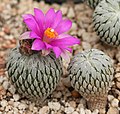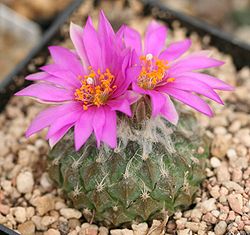| Section | Group | Image | Scientific name | Subspecies | Distribution |
|---|
| Pelecyphora | |  | Pelecyphora aselliformis C.Ehrenb. | | San Luis Potosi, Mexico |
|---|
|  | Pelecyphora strobiliformis (Werderm.) Frič & Schelle ex Kreutz | | Nuevo Leon, San Luis Potosi, Tamaulipas states in Mexico |
| PleuranthaN.P.Taylor | |  | Pelecyphora chihuahuensis (Britton & Rose) D.Aquino & Dan.Sánchez | - Pelecyphora chihuahuensis subsp. chihuahuensis
- Pelecyphora chihuahuensis subsp. henricksonii(Glass & R.A.Foster) D.Aquino & Dan.Sánchez
| Mexico |
|---|
|  | Pelecyphora tuberculosa (Engelm.) D.Aquino & Dan.Sánchez | | New Mexico, Mexico |
| EscobariaBritton & Rose | Sneedii Group |  | Pelecyphora laredoi (Glass & R.A.Foster) D.Aquino & Dan.Sánchez | | Coahuila de Zaragoza - Mexico |
|---|
 | Pelecyphora sneedii (Britton & Rose) D.Aquino & Dan.Sánchez | - Pelecyphora sneedii subsp. sneedii
- Pelecyphora sneedii subsp. orcuttii(Boed.) D.Aquino & Dan.Sánchez
| Mexico (Chihuahua), United States (Arizona, New Mexico, Texas) |
| Vivipara Group |  | Pelecyphora alversonii (J.M.Coult.) D.Aquino & Dan.Sánchez | | Arizona, California |
|---|
| Pelecyphora chlorantha (Engelm.) Stock | | Arizona, California, Nevada, Utah |
 | Pelecyphora hesteri (Y.Wright) D.Aquino & Dan.Sánchez | - Pelecyphora hesteri subsp. grata(M.Kaplan, Kunte & Šnicer) D.Aquino & Dan.Sánchez
- Pelecyphora hesteri subsp. hesteri
| Texas |
 | Pelecyphora vivipara (Nutt.) D.Aquino & Dan.Sánchez | | Canada (Alberta, Manitoba, Saskatchewan ), Mexico (Chihuahua, Coahuila de Zaragoza, Sonora), United States (Arizona, California, Colorado, Kansas, Minnesota, Montana, Nebraska, Nevada, New Mexico, North Dakota, Oklahoma, South Dakota, Texas, Utah, Wyoming) |
| Neobesseya(Britton & Rose) N.P.Taylor | | | Pelecyphora abdita (Řepka & Vaško) D.Aquino & Dan.Sánchez | - Pelecyphora abdita subsp. abdita
- Pelecyphora abdita subsp. tenuispina(Perez Badillo, Delladdio & Raya Sanchez) D.Aquino & Dan.Sánchez
| Mexico (Coahuila) |
|---|
|  | Pelecyphora emskoetteriana (Quehl) D.Aquino & Dan.Sánchez | | Mexico (Coahuila de Zaragoza, Tamaulipas ), United States (Texas) |
| Dasyacantha Group |  | Pelecyphora dasyacantha (Engelm.) D.Aquino & Dan.Sánchez | - Pelecyphora dasyacantha subsp. dasyacantha
- Pelecyphora dasyacantha subsp. chaffeyi(Britton & Rose) D.Aquino & Dan.Sánchez
| Mexico (Chihuahua, Coahuila de Zaragoza, Zacatecas), USA (Texas, New Mexico) |
|---|
| Pelecyphora duncanii (Hester) D.Aquino & Dan.Sánchez | | New Mexico, Texas |
| Pelecyphora lloydii (Britton & Rose) D.Aquino & Dan.Sánchez | | Mexico (Zacatecas) |
 | Pelecyphora minima (Baird) D.Aquino & Dan.Sánchez | | Texas |
 | Pelecyphora robbinsiorum (W.H.Earle) D.Aquino & Dan.Sánchez | | Arizona |
| Missouriensis Group |  | Pelecyphora cubensis (Britton & Rose) D.Aquino & Dan.Sánchez | | Cuba |
|---|
 | Pelecyphora macromeris (Engelm.) D.Aquino & Dan.Sánchez | - Pelecyphora macromeris subsp. macromeris
- Pelecyphora macromeris subsp. runyonii(Britton & Rose) D.Aquino & Dan.Sánchez
| S. New Mexico to W. Texas and NE. Mexico. |
 | Pelecyphora missouriensis (Sweet) D.Aquino & Dan.Sánchez | - Pelecyphora missouriensis subsp. missouriensis
- Pelecyphora missouriensis subsp. asperispina(Boed.) D.Aquino & Dan.Sánchez
| USA ( Arizona, Idaho, Kansas, New Mexico, North Dakota), Mexico (Coahuila de Zaragoza, Nuevo Leon) |
| Pelecyphora zilziana (Boed.) D.Aquino & Dan.Sánchez | | Mexico (Coahuila de Zaragoza) |
|
















